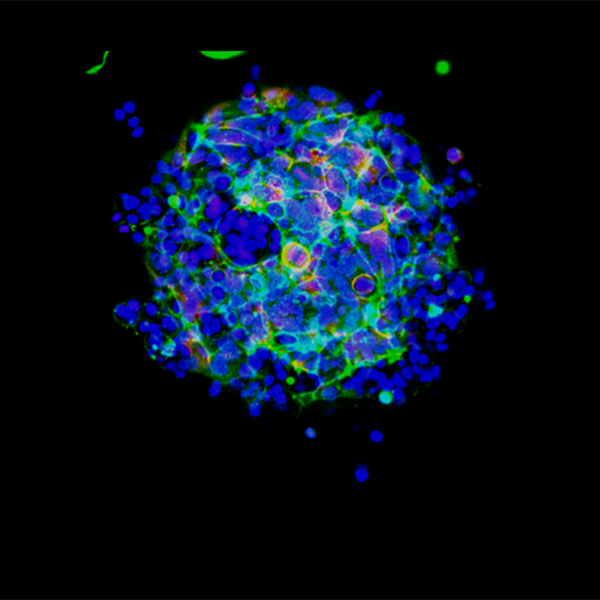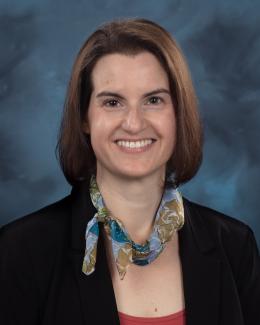A carbon-reducing engine simulated on the world’s fastest supercomputer, a new center to lead research in artificial intelligence coming online and a power record set by the world’s top producer of pulsed neutrons were among the topics featured in Oak Ridge National Laboratory’s most popular news stories of 2023.

The brightly colored photo of “Three-Dimensional Breast Cancer Spheroids” submitted by radiotherapeutics researcher Debjani Pal of ORNL is stunning. The slice from an image of breast cancer tissue, viewed under a confocal microscope, shows a nanobody affecting the HER2 genetic cancer marker in a sample with both HER2-positive and HER2-negative breast cancer cells. The image won the Director’s Choice Award in Oak Ridge National Laboratory’s Art of Science photo competition.
Dry manufacturing process offers path to cleaner, more affordable high-energy EV batteries
Early experiments by ORNL scientists have revealed significant benefits to a dry battery manufacturing process, showing promise for delivering a lighter-weight battery that is durable and able to maintain high energy storage capacity. Such improvements could boost wider electric vehicle adoption, helping to reduce carbon emissions and achieve U.S. climate goals.
Dry manufacturing process offers path to cleaner, more affordable high-energy EV batteries
Early experiments by ORNL scientists have revealed significant benefits to a dry battery manufacturing process, showing promise for delivering a lighter-weight battery that is durable and able to maintain high energy storage capacity. Such improvements could boost wider electric vehicle adoption, helping to reduce carbon emissions and achieve U.S. climate goals.
The world’s most powerful computer, Frontier, helped GE Aerospace develop more energy efficient engines that will consume 20% less fuel and emit 20% less CO2 than today’s most efficient engines. GE’s new engines could save $1 billion in fuel costs per year.
Neutrons see stress in 3D-printed parts, advancing additive manufacturing
ORNL scientists have developed OpeN-AM, a 3D printing platform that uses neutrons to see the additive manufacturing process at the atomic level, allowing scientists to measured strain in a material as it evolves and track how atoms move in response to stress. The system, demonstrated using the VULCAN beamline at the lab’s Spallation Neutron Source, has implications for automotive, aerospace, clean energy and tool-and-die industries.
New approach ‘stacks’ genes for faster plant transformation
ORNL scientists developed a capability to insert multiple genes into plants in a single step, a discovery aimed at accelerating the development of process-advantaged crops for jet biofuels. The ability to test multiple genes simultaneously will help increase the probability of achieving the nation’s goal of displacing 100% of petroleum-based aviation fuel by 2050.
ORNL launches Center for AI Security Research to study AI’s impacts on society, security
The lab announced the establishment of the ORNL Center for Artificial Intelligence Security Research, or CAISER, to address threats already present as governments and industries around the world adopt artificial intelligence and take advantage of the benefits it promises in data processing, operational efficiencies and decision-making. CAISER expands ORNL’s long-standing Artificial Intelligence for Science and National Security research initiative, which integrates the lab’s unique expertise, infrastructure and data to accelerate scientific breakthroughs.
Researchers 3D print moon rover wheel prototype with NASA
ORNL collaborated with NASA to use additive manufacturing technology to 3D print the same kind of wheel as the design the space agency used for its robotic lunar rover. The 3D-printed wheel was modeled on the existing, light-weight wheels of the Volatiles Investigating Polar Exploration Rover, or VIPER, a mobile robot NASA plans to send in 2024 to map ice and other potential resources at the south pole of the moon. The VIPER mission aims to help determine whether life on the moon could be sustained.
Using the Quantinuum H1-1 quantum computer, ORNL researchers observed the unique behavior of a single photon of light and determined the results could ultimately prove to be useful in developing more efficient solar panels. The team’s experiment also demonstrated ORNL’s leadership in quantum computing research by establishing best practices for scientific computing on current quantum systems.
SNS accelerator achieves world-record 1.7-megawatt power level to enable more scientific discoveries
ORNL’s Spallation Neutron Source set a world record when the operating power of its particle accelerator beam reached 1.7 megawatts, substantially improving on the facility’s original design capability. The accelerator’s higher power provides more neutrons for researchers who use the facility to study and improve a wide range of materials for more efficient solar panels, longer-lasting batteries and stronger, lighter materials for transportation. The achievement marks a new operational milestone for neutron scattering in the United States and opens the door to tackling more difficult questions and problems in materials science research.
Superlubricity coating could reduce economic losses from friction, wear
At ORNL, inventors created a novel coating material that could significantly reduce the friction of steel rubbing on steel, which occurs in load-bearing systems from vehicle drive trains to wind turbines. The coating could help grease a U.S. economy that each year loses more than $1 trillion to friction and wear — equivalent to 5% of the gross national product.
In July, ORNL announced Stephen K. Streiffer as the lab’s 12th director. In October, he kicked off his tenure with a focus on enabling staff members, an awareness of the laboratory’s rich history and a commitment to addressing the most significant scientific and technical challenges.
UT-Battelle manages ORNL for the Department of Energy’s Office of Science, the single largest supporter of basic research in the physical sciences in the United States. The Office of Science is working to address some of the most pressing challenges of our time. For more information, please visit energy.gov/science.


